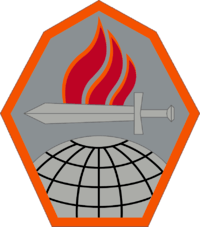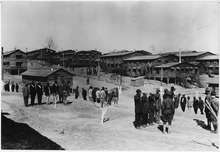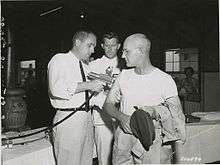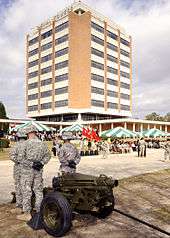Fort Gordon
| Fort Gordon | |
|---|---|
| Augusta, Georgia | |
 | |
| Site information | |
| Owner | United States Federal Government |
| Controlled by |
|
| Site history | |
| In use | October 1941–present |
| Garrison information | |
| Current commander | Maj. Gen. John B. Morrison, Jr. |
| Garrison | U.S. Army Cyber Center of Excellence |
| Occupants |
15th Regimental Signal Brigade 35th Signal Brigade 513th Military Intelligence Brigade 480th Intelligence, Surveillance and Reconnaissance Wing 706th Military Intelligence Group Dwight D. Eisenhower Army Medical Center Navy Information Operations Command, Georgia |


Fort Gordon, formerly known as Camp Gordon, is a United States Army installation established in October 1941. It is the current home of the United States Army Signal Corps , United States Army Cyber Corps, and Cyber Center of Excellence. It was once the home of The Provost Marshal General School and Civil Affairs School. The fort is located slightly southeast of Grovetown, Georgia and southwest of the city Augusta, Georgia. The main component of the post is the Advanced Individual Training for Signal Corps military occupational specialties. In 1966–68 the Army's Signal Officer Candidate School (located at Fort Monmouth during World War II and the Korean War) graduated over 2,200 Signal officers. Signals Intelligence has become more visible and comprises more and more of the fort's duties.
History
World War I era
The United States Army established many war-training camps during World War I. Chamblee, northeast of Atlanta, was selected for one of the state's largest army cantonments. It was named Camp Gordon in honor of John Brown Gordon, who was a major general in the Confederate army, a Georgia governor, a U.S. senator, and a businessman. The camp opened in July 1917, becoming a training site and home of the famous 82nd Airborne Division.[1] The division was composed of men from several different states, but men from Georgia made up almost half its number. This camp was in operation until the sale of real estate and buildings was ordered in 1920. It was abandoned in September 1921. During WWI the US Army Camp Hancock was located in Augusta, Georgia in the general vicinity of the current Daniel Field. Camp Hancock was the home of the 28th Infantry Division from Pennsylvania. Camp Hancock was abandoned and turned over to a caretaker detachment March 27, 1919. From 1919 until 1941, there was no army installation named Camp Gordon in existence, nor was there an installation located near Augusta, Georgia. [2][3] [4]
World War II era
Camp Gordon was approved as the name for a WWII division training camp which began construction in July 1941. The U.S. War Department approved a contract to construct facilities on a new training area near Augusta, in Richmond County, Georgia that had been selected several months earlier. A groundbreaking and flag-raising ceremony took place in October. In response to the attack on Pearl Harbor Colonel Herbert W. Schmidt, camp commander, moved his small staff from his temporary office in the Augusta post office building to the unfinished headquarters building at Camp Gordon on 9 December 1941 and the 4th Infantry Division began to establish operations there.
The post was home to three divisions during the war: the 4th Infantry, the 26th Infantry, and the 10th Armored. From October 1943 to January 1945 Camp Gordon served as an internment camp for foreign prisoners of war. From May 1945 until April 1946 the U.S. Army Personnel and Separation Center processed nearly 86,000 personnel for discharge from the Army.[5]
Post-World War II
From early 1946 to June 1947, the U.S. Army Disciplinary Barracks for convicted criminals was located at Camp Gordon, and the installation was scheduled for deactivation. In September 1948 the Army relocated the Military Police School from Carlisle Barracks, Pennsylvania, to Camp Gordon, and in October 1948 a Signal Corps training center was activated.
On 21 March 1956, the post was renamed Fort Gordon.
During the 1950s and into the 1980s Fort Gordon served as a basic-training camp. It also provided advanced individual training for troops. Since June 1985 Fort Gordon has been the home of the Signal Corps Regiment, the branch of the U.S. Army responsible for providing and maintaining information systems and communication networks. The US Army Signal School's primary purpose is to conduct specialized instruction for all Signal Corps military and civilian personnel.
During the Vietnam War, Fort Gordon was home to Camp Crocket, an area of the post conducting 9-week advance airborne infantry training courses for soldiers in line to attend the remaining 3 weeks of Airborne training at Fort Benning, Georgia, and then be assigned to Airborne units in Vietnam. The location closed as the war ended and today the site is overgrown with pine trees.[6] Between 1966 and 68, approximately 2,200 Signal Officers were trained at Fort Gordon's Signal Officer Candidate School (OCS), before all US Army branch OCSs were merged with the Infantry OCS at Fort Benning. During the Vietnam War, Ft. Gordon was also a training location for the Military Police Corps, located in the World War II wooden barracks corridor between Brainard Ave. and Avenue Of The States, and in the Brems Barracks region of the fort (which was also later used in the 1980s for training radioteletype operators).
In September 2014, the US Army established the US Army Cyber branch and Cyber School at Fort Gordon. Both the Signal School and Cyber School are subordinate elements of the US Army Cyber Center of Excellence, the headquarters which was formerly known as the US Army Signal Center of Excellence. The chiefs of the Signal and Cyber branches - the Chief of Signal and the Chief of Cyber - are dual hatted as the commandants of their respective schools and serve as the proponent chiefs for their branches and regiments.
In October 2016, Fort Gordon marked its 75th year as a continuous active US military installation near Augusta, GA.
Units and facilities

Fort Gordon's official name is the U.S. Army Cyber Center of Excellence & Fort Gordon, or CyberCoE&FG. While the TRADOC school itself is the primary function, the post is home to the following active-duty tenant units:
- 15th Regimental Signal Brigade
- 369th Signal Battalion
- 442nd Signal Battalion
- 551st Signal Battalion
- Ordnance Training Detachment - Gordon
- 35th Signal Brigade
- 63rd Signal Battalion
- 67th Signal Battalion
- 50th Signal Battalion (Attached to Fort Bragg, NC)
- 480th Intelligence, Surveillance and Reconnaissance Wing
- 513th Military Intelligence Brigade
- 202nd Military Intelligence Battalion
- 297th Military Intelligence Battalion
- 35th Military Police Detachment
- 706th Military Intelligence Group
- 707th Military Intelligence Battalion
- 434th Signal Corps Band
- 7th Signal Command
- 359th Signal Brigade
- 92nd Engineers Combat Heavy
- 206th Military Intelligence Battalion
- 31st Intelligence Squadron
- 324th Signal Battalion
- Cryptologic Support Battalion
- Naval Network Warfare Command
- 338th Training Squadron
- Cyber Battle Laboratory (CBL)
- The post also hosts a joint-service command, National Security Agency/Central Security Service Georgia, formerly known as the Gordon Regional Security Operations Center. The Army's 706th MI Group works there alongside units from the 25th Air Force, Naval Network Warfare Command (Navy Information Operations Command, Georgia),[7] Marine Corps Intelligence Activity as well as civilians from the National Security Agency (NSA).
Considered a mission partner on Fort Gordon is the Dwight D. Eisenhower Army Medical Center (DDEAMC) as well as a dental laboratory. The facility treats active duty military and their families, as well as many of the military retiree community in the Central Savannah River Area.
Fort Gordon has approximately 30,000 military and civilian employees and currently has an estimated $1.1 billion economic impact on the Augusta-Richmond County economy.
Training and current activities
Fort Gordon houses the Headquarters for the United States Army Cyber School.[8] The Signal school and the Cyber school are both actively training soldiers. The Signal school focuses primarily on communications technology that is currently being utilized by the United States Army. One MOS or Military Operational Specialty that is currently being trained at Fort Gordon by the Signal School are the Signal Support System Specialists whose MOS designation is 25U or 25 Uniform. Soldiers that can perform both Signal and Cyber related jobs are in high demand throughout the army and because of this Fort Gordon has a steady stream of soldiers training on base in those disciplines.[9]
Future activities and facilities
Due to increases in the need and use of cyber technology the US Army decided to consolidate the United States Army Cyber Command into one location. Fort Gordon along with Fort George Meade were in the running to receive the command.[10] In December 2013 it was announced that Fort Gordon was selected.[11]
Berlin Wall display
In Freedom Park, located off Rice Road, across from Barton Field, is a display of two sections of the Berlin Wall, as well as a sign from the wall.[12]
References
- ↑ Hudson, Paul Stephen; Mirza, Lora Pond (2017). "Transforming the Atlanta Home Front: Camp Gordon during World War I". Georgia Historical Quarterly. 101 (2): 147–165. Retrieved 20 February 2018.
- ↑ Camp Gordon historical marker
- ↑ Order of Battle of the United States Land Forces in the World War: Zone of the Interior Territorial Departments Tactical Divisions Organized in 1918 Posts, Camps, and Stations Vol 3 Part 2. (Center of Military History, United States Army, Washington DC 1988) pp. 821-822 and 826-828.
- ↑ The New Georgia Encyclopedia, World War I in Georgia: Federal Installations and War Camps. Retrieved 2011-05-05.
- ↑ Dunn, Mark (10 June 2005). "New Georgia Encyclopedia: Fort Gordon". Retrieved 2008-02-08.
- ↑ "Vietvet.org". Retrieved 4 October 2014.
- ↑ "NIOC Georgia History". NAVIOCOM Georgia. United States Navy. Retrieved 2008-12-10.
- ↑ Gallagher, Matt (March 27, 2018). "Army of 01101111: The Making of a Cyber Battalion". Wired. Archived from the original on June 14, 2018.
- ↑ "Connect from Home: UofL Libraries". search-proquest-com.echo.louisville.edu. Retrieved 2018-02-02.
- ↑ "The Army's cyber command facility with a Star Trek-inspired showroom may be falling apart". Washington Post. Retrieved 4 October 2014.
- ↑ "Army Settles On Augusta For Cyber Forces Headquarters". nextgov.com. 20 December 2013. Retrieved 22 December 2013.
- ↑ Fort Gordon, p. 117, at Google Books
External links
| Wikimedia Commons has media related to Fort Gordon, Georgia. |
- Fort Gordon Pictorial History Book
- Fort Gordon
- WW1 account of Life at Camp Gordon"Letters from Ward B Scripture of the 328th Infantry to his Mother during WW1"
- "NSA Seeks to Pour Hundreds of Millions Into Surveillance Infrastructure," The Peacock Report, April 20, 2006
- Dwight D. Eisenhower Army Medical Center
- CSRA Alliance for Fort Gordon – Group that sought to keep Fort Gordon open during the 2005 Base Realignment and Closure round
- U.S. Army Signal Corps OCS Association
- Fort Gordon Directorate of Morale, Welfare and Recreation
- New Georgia Encyclopedia information
- Battle Command Battle Lab
- Camp Gordon historical marker
33°24′48″N 82°8′7″W / 33.41333°N 82.13528°WCoordinates: 33°24′48″N 82°8′7″W / 33.41333°N 82.13528°W

.svg.png)